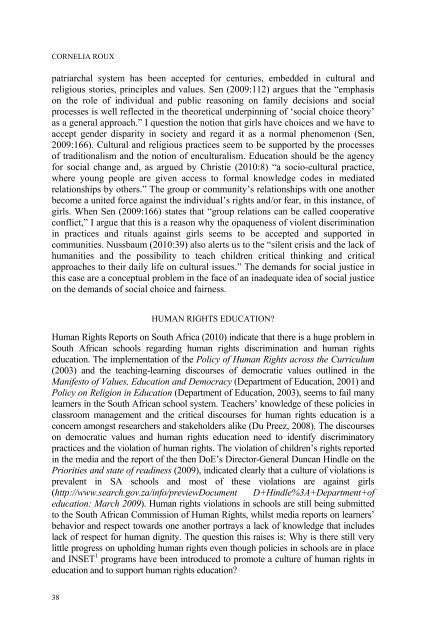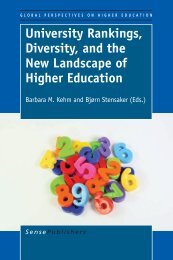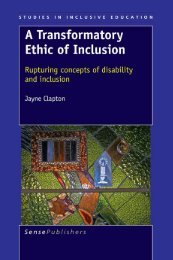Safe Spaces Human Rights Education in Diverse Contexts
Safe Spaces Human Rights Education in Diverse Contexts
Safe Spaces Human Rights Education in Diverse Contexts
Create successful ePaper yourself
Turn your PDF publications into a flip-book with our unique Google optimized e-Paper software.
CORNELIA ROUX<br />
patriarchal system has been accepted for centuries, embedded <strong>in</strong> cultural and<br />
religious stories, pr<strong>in</strong>ciples and values. Sen (2009:112) argues that the “emphasis<br />
on the role of <strong>in</strong>dividual and public reason<strong>in</strong>g on family decisions and social<br />
processes is well reflected <strong>in</strong> the theoretical underp<strong>in</strong>n<strong>in</strong>g of ‘social choice theory’<br />
as a general approach.” I question the notion that girls have choices and we have to<br />
accept gender disparity <strong>in</strong> society and regard it as a normal phenomenon (Sen,<br />
2009:166). Cultural and religious practices seem to be supported by the processes<br />
of traditionalism and the notion of enculturalism. <strong>Education</strong> should be the agency<br />
for social change and, as argued by Christie (2010:8) “a socio-cultural practice,<br />
where young people are given access to formal knowledge codes <strong>in</strong> mediated<br />
relationships by others.” The group or community’s relationships with one another<br />
become a united force aga<strong>in</strong>st the <strong>in</strong>dividual’s rights and/or fear, <strong>in</strong> this <strong>in</strong>stance, of<br />
girls. When Sen (2009:166) states that “group relations can be called cooperative<br />
conflict,” I argue that this is a reason why the opaqueness of violent discrim<strong>in</strong>ation<br />
<strong>in</strong> practices and rituals aga<strong>in</strong>st girls seems to be accepted and supported <strong>in</strong><br />
communities. Nussbaum (2010:39) also alerts us to the “silent crisis and the lack of<br />
humanities and the possibility to teach children critical th<strong>in</strong>k<strong>in</strong>g and critical<br />
approaches to their daily life on cultural issues.” The demands for social justice <strong>in</strong><br />
this case are a conceptual problem <strong>in</strong> the face of an <strong>in</strong>adequate idea of social justice<br />
on the demands of social choice and fairness.<br />
38<br />
HUMAN RIGHTS EDUCATION?<br />
<strong>Human</strong> <strong>Rights</strong> Reports on South Africa (2010) <strong>in</strong>dicate that there is a huge problem <strong>in</strong><br />
South African schools regard<strong>in</strong>g human rights discrim<strong>in</strong>ation and human rights<br />
education. The implementation of the Policy of <strong>Human</strong> <strong>Rights</strong> across the Curriculum<br />
(2003) and the teach<strong>in</strong>g-learn<strong>in</strong>g discourses of democratic values outl<strong>in</strong>ed <strong>in</strong> the<br />
Manifesto of Values, <strong>Education</strong> and Democracy (Department of <strong>Education</strong>, 2001) and<br />
Policy on Religion <strong>in</strong> <strong>Education</strong> (Department of <strong>Education</strong>, 2003), seems to fail many<br />
learners <strong>in</strong> the South African school system. Teachers’ knowledge of these policies <strong>in</strong><br />
classroom management and the critical discourses for human rights education is a<br />
concern amongst researchers and stakeholders alike (Du Preez, 2008). The discourses<br />
on democratic values and human rights education need to identify discrim<strong>in</strong>atory<br />
practices and the violation of human rights. The violation of children’s rights reported<br />
<strong>in</strong> the media and the report of the then DoE’s Director-General Duncan H<strong>in</strong>dle on the<br />
Priorities and state of read<strong>in</strong>ess (2009), <strong>in</strong>dicated clearly that a culture of violations is<br />
prevalent <strong>in</strong> SA schools and most of these violations are aga<strong>in</strong>st girls<br />
(http://www.search.gov.za/<strong>in</strong>fo/previewDocument D+H<strong>in</strong>dle%3A+Department+of<br />
education: March 2009). <strong>Human</strong> rights violations <strong>in</strong> schools are still be<strong>in</strong>g submitted<br />
to the South African Commission of <strong>Human</strong> <strong>Rights</strong>, whilst media reports on learners’<br />
behavior and respect towards one another portrays a lack of knowledge that <strong>in</strong>cludes<br />
lack of respect for human dignity. The question this raises is: Why is there still very<br />
little progress on uphold<strong>in</strong>g human rights even though policies <strong>in</strong> schools are <strong>in</strong> place<br />
and INSET 1 programs have been <strong>in</strong>troduced to promote a culture of human rights <strong>in</strong><br />
education and to support human rights education?














